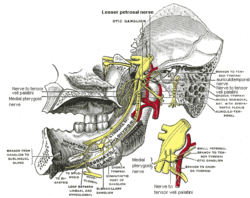Structure and Relations:
- The otic ganglion is a small, oval-shaped, flattened parasympathetic ganglion.
- It is located below the foramen ovale in the infratemporal fossa and on the medial surface of the mandibular nerve.
- It is in relation with the trunk of the mandibular nerve, the cartilaginous part of the auditory tube, the origin of the tensor veli palatini, the middle meningeal artery, and the nerve to the medial pterygoid.
Connections:
- Preganglionic parasympathetic fibers originate in the inferior salivatory nucleus of the glossopharyngeal nerve.
- They pass via the tympanic branch of the glossopharyngeal nerve, the tympanic plexus, and the lesser petrosal nerve to reach the otic ganglion.
- Synapse occurs in the otic ganglion, and postganglionic fibers pass through communicating branches to the auriculotemporal nerve.
- The auriculotemporal nerve conveys the fibers to the parotid gland, causing vasodilator and secretomotor effects.
- The sympathetic root of the otic ganglion is derived from the plexus on the middle meningeal artery and contains post-ganglionic fibers from the superior cervical ganglion.
Clinical Significance:
- Freys syndrome is a complication of parotid gland surgery, caused by abnormal connections between the parotid gland and sweat glands of the face.
- Injury to the branches of the auriculotemporal nerve within the otic ganglion leads to gustatory sweating.
- Salivation triggers perspiration and flushing of the pre-auricular region.
Additional Images:
- Plan of the facial and intermediate nerves and their communication with other nerves.
- Diagram of the efferent sympathetic nervous system.
References:
- The information in this article is from page 897 of the 20th edition of Gray's Anatomy (1918).
- Shimizu T (1994). Distribution and pathway of the cerebrovascular nerve fibers from the otic ganglion in the rat: anterograde tracing study.
- J. Auton. Nerv. Syst. 49 (1): 47–54. doi:10.1016/0165-1838(94)90019-1. PMID7525688.
The otic ganglion is a small parasympathetic ganglion located immediately below the foramen ovale in the infratemporal fossa and on the medial surface of the mandibular nerve. It is functionally associated with the glossopharyngeal nerve and innervates the parotid gland for salivation.
| Otic ganglion | |
|---|---|
 Mandibular division of trigeminal nerve, seen from the middle line. The small figure is an enlarged view of the otic ganglion. | |
 The otic ganglion and its branches. | |
| Details | |
| From | lesser petrosal nerve |
| Innervates | parotid gland |
| Identifiers | |
| Latin | ganglion oticum |
| TA98 | A14.3.02.014 |
| TA2 | 6671 |
| FMA | 6967 |
| Anatomical terms of neuroanatomy | |
It is one of four parasympathetic ganglia of the head and neck. The others are the ciliary ganglion, the submandibular ganglion and the pterygopalatine ganglion.
otic ganglion (plural otic ganglia)